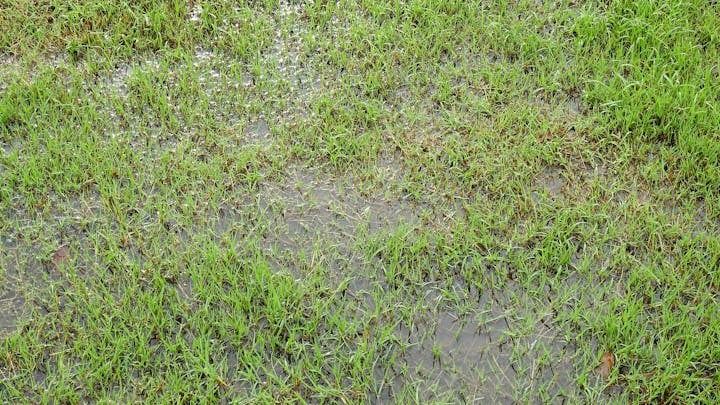
Winter 2023/24 - Too wet to be good!
If your lawn is unusually wet it may start showing signs of yellowing and die-back. Here is some help to stop it deteriorating further and help it recover when the rain stops.
If your lawn is drowning
Some lawns, particularly those with clay soil, poor drainage and/or shade may begin to thin quite alarmingly or turn yellow. Basically the roots are so saturated the grass is drowning. So, what to do?
If this is a one off for you and your lawn, don't panic and start digging it up or installing drainage. We could just as easily have a long hot summer and drainage will be the opposite of what you want! So, just leave it alone and try not to look at it if it upsets you!
If it has thinned or is not in good condition you should follow the procedure for raking or scarifying the lawn followed by over seeding and fertiliser in the spring. This will repair the lawn and may even improve it. Some aeration wouldn't go amiss either. The seed you use should be a close match to your original if this is a one off wet lawn event. If however, your lawn suffers frequent bouts of wet and dry then use our Staygreen Grass Seed. It is coarser than other grasses so not suitable for the fine lawn enthusiast.
You can find lots of guidance on the following pages:
- Spring Lawn Repair
- How to Recover a Water Logged Lawn
- Winter Lawn Damage
- Winter Die-back & Lawn Problems
- Winter Lawn Care Tips
- Raking/Scarifying Video
- Over Seeding Video
In fact pretty much all the help you need can be found in one place Lawn Trends
Help the Lawn Now!
So, the lawn is a mess, you want to sort it but you know it isn't going to grow back and seed isn't going to germinate in the winter! Repair needs to wait until spring but what you can do is try and stop it getting any worse.
Firstly acknowledge it's not only the grass that's unhealthy, it's also the soil. As soon as possible put some Seaweed into the lawn. This stimulates biological activity and nutrient uptake which will have almost stopped. Then during a mild spell between now and February put in our Winter Green fertiliser. It is low in nitrogen so won't stimulate much leaf growth but it will strengthen the grass, help the roots, reduce worm activity a little and also kill any moss that is starting to take advantage of the stressed lawn. This should keep things ticking over until warmer drier weather enables a full assessment and repair. Contact us if you need help but the links above should cover it all.
If the wet conditions persist into spring or the weather is particularly mild and growth starts then this will help with the mowing:
Cutting Wet Grass
It's difficult to mow wet grass at the best of times but if you leave it it'll be even longer and therefore harder.
If you follow these instructions you will do more good than harm and prevent a bigger problem later on, however, if the soil is wet and soft stay off until it firms up.
Put the mower on the top setting
This is the opposite of what you'd logically do but do it anyway. Raising the setting to maximum on a cylinder mower can be a problem as these machines don’t like mowing long grass! Anyway the benefits are:
- Longer grass grows more slowly
- The grass will use less energy growing and use it instead for roots and health
- The extra leaf will aid in photosynthesis in these cloudy conditions improving health and disease resistance
- When you mow you'll mow higher up the leaf where it is drier
- The mower will ride on a cushion of grass with fewer muddy tracks
- You'll have fewer weeds and less moss because of the grass density
A few tips for mowing wet grass
- Squeegee the lawn before mowing. Grab a length of hose and drag it across the lawn to knock any water down into the soil
- Mow in the afternoon or evening on a dry day which gives the grass leaves a chance to dry
- A windy day is even better
- Keep the mower clean - any dry grass left underneath from a previous cut attracts wet grass like a magnet
- A sharp mower is even better
- A cylinder mower is useless so try and borrow a rotary